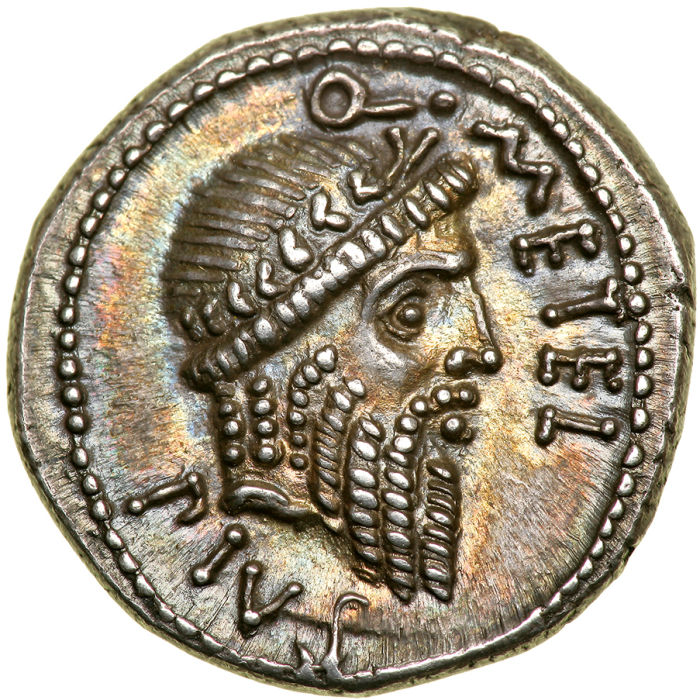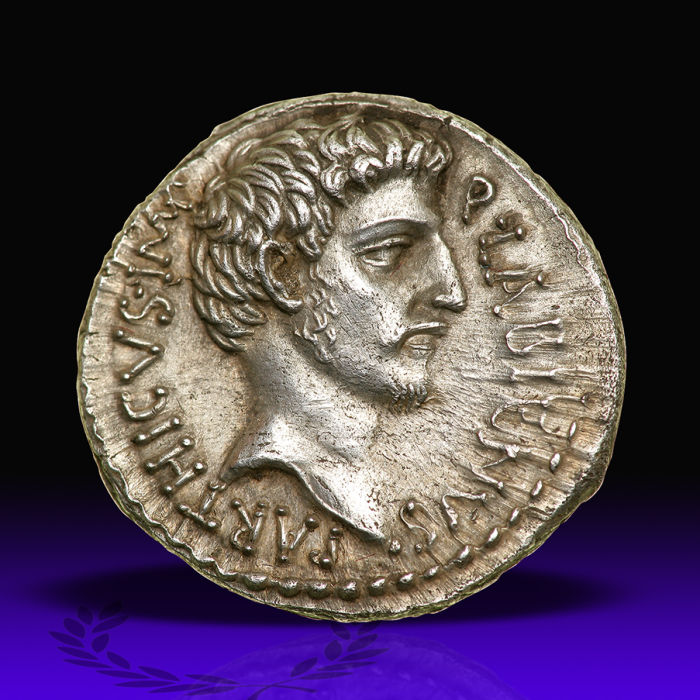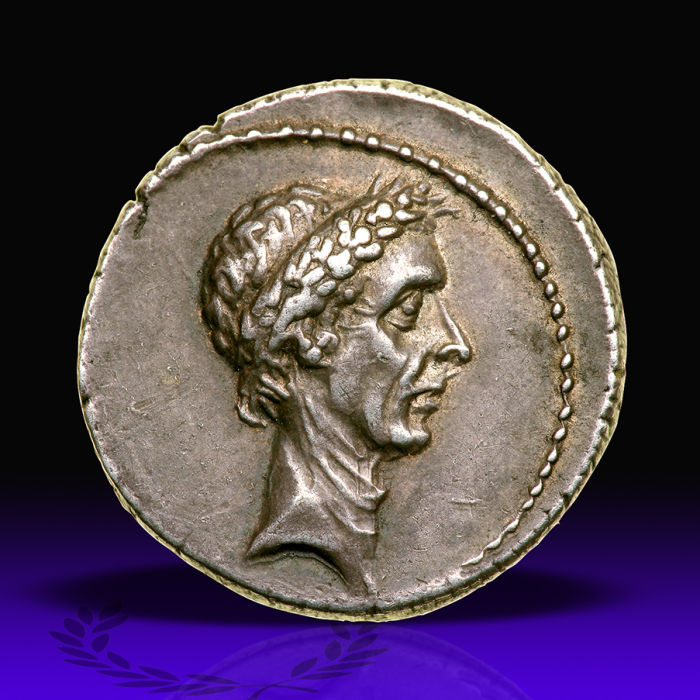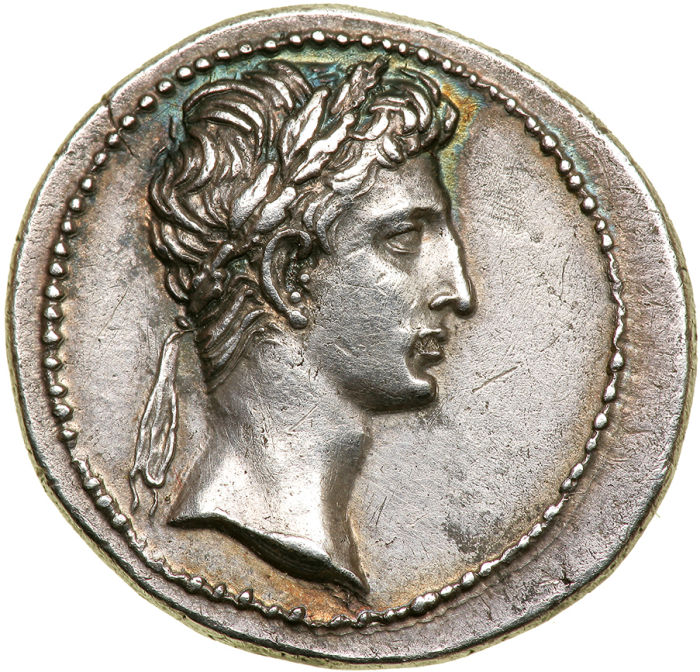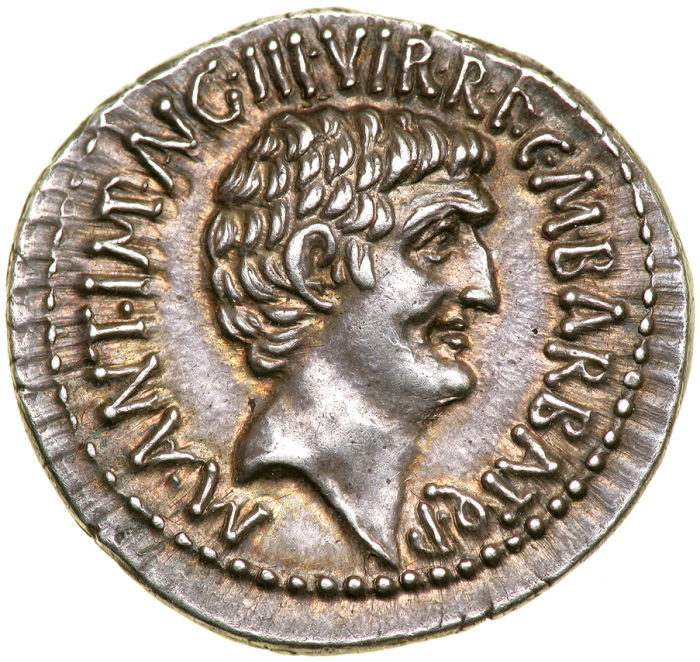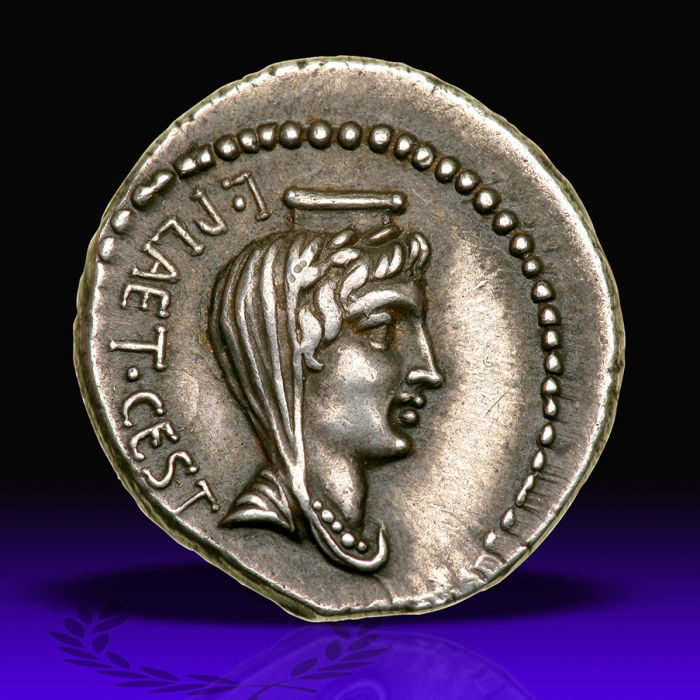|
Octavian. Silver Denarius (3.9 g), 30 BC. Uncertain Italian mint (Rome?). Victory standing right on prow, holding wreath and palm. Reverse IMP CAESAR in exergue, Emperor, holding branch and reins, driving triumphal quadriga right. RIC 264; HCRI 416; BMC 617; RSC 115. Boldly struck on a full flan and well centered. Lovely old cabinet toning. Superb Extremely Fine.
Sear states that this is probably the first type of the IMP CAESAR series, having replaced an identical type with the legend CAESAR DIVI F. While the obverse type certainly harkens back to Actium, the reverse commemorates Octavian's entry into Alexandria, where he immediately seized the Ptolemaic treasury. This coin, in fact, was likely struck from the first batch of Ptolemaic silver received in Rome.
Estimated Value $3,000 - 3,500.
Ex The Bru Sale 3 (6 May 2011), 74; Tradart (12 December 1991), 242; Bank Leu 20 (25-26 April 1978), 197.
denarii collection - roman imperitorial |
|
|
Q. Metellus Pius Scipio. Silver Denarius (4.07 g), 47-46 BC. Military mint traveling with Scipio in Africa. Imperator, committed sucide in 46 BC. Q METEL above, PIVS below, laureate head of Jupiter right. Reverse SCIPIO above, IMP in exergue, elephant advancing right. Crawford 459/1; HCRI 45; Sydenham 1050; Caecilia 47. Rare. Perfectly struck and centered on a full flan with gorgeous iridescent toning. A remarkable specimen. Superb Extremely Fine.
A Pompeian loyalist, Q. Metellus Pius Scipio introduced the legislation that recalled Caesar from his Gallic command, thus precipitating the Civil Wars. This handsome denarius was struck while Scipio was in supreme command of the Pompeian forces in North Africa, the elephant an obvious reference to the province, and was probably struck during the later stages of the campaign in a mobile mint traveling alongside the forces (stylistically it is quite distinct from the coins of Scipio struck at the provincial capital of Utica). In 46 BC, Caesar finally managed to corner the Pompeians at Thapsus, where he inflicted on them a crushing defeated. After the battle Scipio committed suicide, knowing that despite Caesar's usual leniency towards his enemies he would not allow so persistent an foe as Scipio to survive.
Estimated Value $5,000 - 6,000.
Ex NAC 62 (6 October 2011), 2001; Spink 5014 (28 September 2005), 386.
denarii collection - roman imperitorial |
|
|
Q. Labienus. Silver Denarius (3.74 g), 40 BC. Uncertain mint in Syria or southeastern Asia Minor. Imperator, executed in 39 BC. Q LABIENVS PARTHICVS IMP, bare head of Labienus right. Reverse Horse standing right on ground line, wearing saddle with quiver attached and bridle. Crawford 524/2; Hersh 23; HCRI 341; Sydenham 1357; RSC 2. Extremely Rare. Boldly struck with a magnificent portrait of superb style in high relief, struck on a full flan, unusually fine metal and delicately toned. Among the finest specimens known. Superb Extremely Fine.
Quintus Labienus was the son of the Pompeian cavalry commander Titus Labienus. He sided with Brutus and Cassius in the war between the Republicans and the Triumvirs, and during the winter of 43/2 BC was sent by Cassius on an embassy to seek Parthian assistance in the Republican cause. Before he was able to do accomplish this task, however, he received the devastating news that Brutus and Cassius had been defeated at Philippi. Thus he found himself in the unpleasant situation of being stranded in Parthia and unable to return to Rome, where his former enemies were now unquestionably in control and would certainly execute him for being a traitor if he were to return.
With nothing to lose, Labienus convinced King Orodes II to allow him a force of 20,000 cavalry, and with the king's son, Pacorus, he marched into Syria. Labienus and Pacorus, splitting the command between them, quickly overcame Roman resistance, defeating the local governor, Decidius Saxa. While Labienus continued into southern Asia Minor, Pacorus headed west and south into Phoenicia and Palestine. Although Antony realized the seriousness of the situation, his attention was called for in the West. He therefore sent his legate Ventidius Bassus with eleven legions to oppose the Parthian invasion, and Bassus routed the Parthian cavalry at Mt. Taurus where Labienus was killed.
The obverse of this extremely rare issue shows the handsome portrait of Labienus along with his name and titles, while the reverse depicts a saddled horse complete with archer's bow-case, a feature used by the Parthians who were most renowned for their mounted archers. Thus, the coin seems to have been designed to appeal to both a Roman and a Parthian audience, although perhaps shortsighted, as certainly no Roman would have considered the design as anything less than unconscionable. In any case, the extreme rarity of the coins today suggests the majority of them were melted down shortly after Labienus' defeat.
Estimated Value $150,000 - 200,000.
Ex S. C. Markoff Collection (NAC 62, 6 October 2011), 2009.
denarii collection - roman imperitorial |
|
|
Brutus. Silver Denarius (3.82 g), 42 BC. Military mint traveling with Brutus and Cassius in western Asia Minor or northern Greece. P. Servilius Casca Longus, moneyer. CASCA behind, LONGVS before, Laureate and bearded head of Neptune right; trident below. Reverse BRVTVS behind, IMP before, Victory advancing right, breaking diadem tied with fillet and holding palm; below, broken scepter. Crawford 507/2; HCRI 212; Sydenham 1298; RSC 3. Boldly struck and well centered. Needle sharp in detail, lustrous and delicately toned. Superb Extremely Fine.
On this splendid coin the image of Victory trampling upon a broken scepter and tearing the diadem powerfully evoke the long tradition of Roman hatred for monarchical rule. It was rumored that Julius Caesar had inclined to become king, purportedly wearing red boots as the Roman kings had worn and having his statue placed next to those of the kings, and these were all used by the tyrannicides to justify his assassination. The obverse type of Neptune was an obvious choice for Casca, who was the commander of Brutus' fleet.
Estimated Value $10,000 - 12,000.
Ex Helios 2 (25-26 November 2008), 221.
denarii collection - roman imperitorial |
|
|
Gaius Caligula, with Agrippina I. Silver Denarius (3.69 g), AD 37-41. Lugdunum, AD 37/8. C CAESAR AVG GERM P M TR POT, bare head of Gaius right. Reverse AGRIPPINA MAT C CAES AVG GERM, draped bust of Agrippina I right, hair tied in queue at back of neck. RIC 8; Giard 169; BMC 8; RSC 4. Two magnificent portraits of the finest style perfectly struck and centered on a full flan. Traces of luster still present and lightly toned. Very rare and among the finest examples known. Superb Extremely Fine.
Perhaps more than any other emperor of Rome Caligula honored his family on his coinage, both living and deceased members. Besides his surviving sisters, amongst those so honored were his great-grandfather Augustus, his grandfather Agrippa, his father Germanicus, and his mother and his two brothers, Agrippina I and Nero and Drusus Caesars, the latter three succumbing in the family's contest for power against Sejanus, Tiberius's notorious Praetorian Prefect.
Early in his reign, Caligula journeyed to the island of Pandataria, where his mother had died while cruelly imprisoned at the order of Tiberius, and recovered her ashes. Agrippina had been a strong critic of Tiberius' principate, questioning him about the mysterious circumstances of her husband's death and also accusing him of having attempted to poison her. Under Sejanus' manipulation, Tiberius' animosity towards her and her family grew increasingly stronger, which eventually lead to them being convicted of plotting against him. Nero starved to death while imprisoned in Rome, and Drusus committed suicide shortly after the trial. Agrippina, however, was banished to the island of Pandataria where she was imprisoned under very brutal circumstances (she lost an eye while being flogged, and she was regularly withheld nourishment). Eventually she died there of starvation.
Estimated Value $25,000 - 30,000.
Ex S. C. Markoff Collection (NAC 62, 6 October 2011), 2020.
denarii collection - roman imperitorial |
|
|
Julius Caesar. Dictator from 49 BC, assassinated 44 BC. Silver Denarius (3.89 g), 43 BC. Rome. L. Flaminius Chilo, moneyer. Laureate head of Julius Caesar right. Reverse L FLAMINIVS III VIR, female figure (Venus or Pax) standing facing, head left, holding caduceus and scepter. Crawford 485/1; HCRI 113; Sydenham 1089; RSC 26. Well struck on a large flan. A remarkable realistic portrait of fine style. Attractive old cabinet tone with a hint of iridescense. Superb Extremely Fine.
We know very little about the moneyer Chilo, and it may be that he should be identified with the 'Cillo' who was proscribed late in the year that this coin was struck, having run afoul of the Triumvirs, Antony and Octavian. If so, this obviously pro-Caesarian type did not save him.
The identity of the female figure on the reverse is uncertain. The type resembles the moneyer issues of the preceding year, which portray Venus standing left, holding Victory and scepter. In this case, however, the goddess holds a caduceus, a symbol most associated with the personification Felicitas or happiness. It may be that instead of Venus the figure is the goddess Pax. Pax is often shown holding a caduceus, which represents the stability associated with peaceful times.
Estimated Value $30,000 - 35,000.
denarii collection - roman imperitorial |
|
|
Augustus. Silver Denarius (3.87 g), 27 BC-AD 14. Uncertain mint in the East, ca. 27 BC or a little later. Laureate head of Augustus right. Reverse AVGVSTVS, capricorn right, cornucopiae on its back, holding rudder and globe. RIC 541 (same obv. die); BMC 664 (same obv. die); RSC 23a. A superb portrait struck in high relief. Lightly toned. Extremely Fine.
Although there is a problem of chronology that has not been clearly sorted, Augustus advertised his birth sign as Capricorn. The capricorn was a half terrestrial, half marine being, and played a prominent role in Augustan propaganda, seen on several coin types as well as in other media. Here the capricorn with globe seems to signify Augustus' power over land and sea. The rudder and cornucopiae are terrestrial attributes of the goddess Bona Fortuna, reminding us of Augustus' role in bringing peace and good fortune to the Empire after the devastating civil wars of the 40s and 30s BC.
For an enlightening discussion of Augustus' horoscope and it's use in imperial propaganda, see T. Barton, "Augustus and Capricorn: Astrological Polyvalency and Imperial Rhetoric," JRS 85, 1995, pp. 31-51.
Estimated Value $5,000 - 6,000.
Ex NAC 40 (16 May 2007), 629.
denarii collection - roman imperitorial |
|
|
Cnaeus Pompey Jr. Silver Denarius (4.02 g), 46-45 BC. Corduba. Elder son of Pompey the Great, Imperator, executed in 45 BC. IMP CN MAGN, bare head of Pompey the Great right. Reverse PR Q to left, M MINAT / SABIN in two lines in exergue, Spanish city-goddess standing right, wearing turreted headdress, holding caduceus and clasping hands with Pompeian solder standing facing; to right, another city-goddess standing left, crowning soldier and holding trophy over shoulder. Crawford 470/1c; HCRI 50; Sydenham 1038; RSC 11 (Pompey the Great). An absolutely incredible specimen! Well struck and perfectly centered, all delicately toned. Important Rarity and one of the finest known. Superb Extremely Fine.
Crawford records just five obverse and eight reverse dies for this issue, which suggests this very rare coin was introduced only shortly before Caesar's decisive victory over the Pompeian forces in Spain at Munda in 45 BC. The obverse features the portrait of the deceased Pompey, the central figure in opposition to Caesar until his tragic assassination in Egypt after Pharsalus, while the reverse alludes to Spanish support for the Pompeian cause. Although this issue was very limited to begin with and but few coins remain today (perhaps no more than a dozen specimens all told), it would seem that the coins circulated for some time as most examples exhibit at least some wear. This specimen, on the other hand, is quite pristine, struck on excellent metal, and is likely the finest example in existence.
Estimated Value $35,000 - 40,000.
Ex The Rubicon Collection (Heritage 3015, 7 September 2011), Previously from Stacks (private purchase).
denarii collection - roman imperitorial |
|
|
Mark Antony & Octavian. Silver Denarius (3.76 g), 41 BC. Ephesus. M. Barbatius Pollio, quaestor pro praetore. M ANT I(MP) (AV)G III VIR R P C M BARBAT Q P, bare head of Mark Antony right. Reverse CAESAR IMP PONT III VIR R P C, bare head of Octavian right. Crawford 517/2; HCRI 243; Sydenham 1181; RSC 8a. Boldly struck on a broad flan. Beautiful old cabinet toning with hints of iridescense. Superb Extremely Fine.
Mark Antony is reported to have lived extravagantly while in the East, and he exacted large sums from the cities of Asia Minor to finance this lifestyle. It is certainly from these funds where he obtained the bullion to produce this extensive and handsome coinage, struck with the name of his lieutenant M. Barbatius Pollio. Pollio's colleagues, M. Cocceius Nerva (a distant ancestor of the future emperor Nerva) and L. Gellius Poplicola, also struck similar types honoring both Antony's fellow triumvir, Octavian and his brother, Lucius Antony, but the majority are of a different style and are believed to have been struck after Antony's departure from Ephesus.
Estimated Value $4,000 - 5,000.
Ex LHS 100 (23-24 April 2007), 455.
denarii collection - roman imperitorial |
|
|
Brutus. Silver Denarius (3.76 g), 42 BC. Military mint traveling with Brutus and Cassius in western Asia Minor or northern Greece. L. Plaetorius Cestianus, moneyer. L PLAET CEST behind, laureate, veiled and draped female bust right, her head surmounted by polos. Reverse BRVT IMP, sacrificial axe and simpulum (or culullis). Crawford 508/2; HCRI 214; Sydenham 1300; RSC 2. Very Rare. Boldly struck in high relief and fine style. A lovely example with attractive old cabinet toning. Extremely Fine.
The identification of the female depicted on the obverse is uncertain. Older catalogues refer to her as Ceres, the Roman goddess of agriculture, while Crawford suggests Diana, but the type is ambiguous. Like the earlier issue in the name of Brutus struck by Cassius' legate, P. Lentulus Spinther, on the reverse we see again Brutus' priestly emblems of the pontificate, suggesting the divine right of the liberators' cause. The issue was struck immediately preceding the fateful battle of Philippi, and was perhaps Brutus' penultimate issue, the last of course being the renowned Eid Mar type which also appears in this sale.
Estimated Value $25,000 - 30,000.
Ex NAC 70 (16 May 2013), 184; Virgil M. Brand Collection, pt. 3 (Sotheby's, 9 June 1983), 238; Ernst Herzfelder Collection (Brüder Egger XLIII, 14 April 1913), 55.
denarii collection - roman imperitorial |
|


